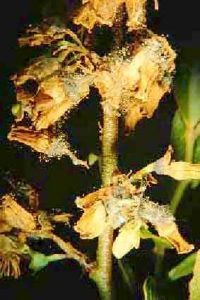

Spray with Iprode, Chariot, Nature gold, Sporeguard, Megaprode Lock, Pilote and dipping in Botristop, Botriguard, Fastruno, Biosure.Proper hygiene by removing the plant debris within then beds and sanitizing the harvesting tools Botrytis is easily diagnosed by the fluffy gray mold produced on blighted plant parts under moist conditions.Maintain proper aeration within the plants to prevent fungal development.Ensure the plant canopies are dry to prevent the development of the fungus.INSIGHT: The fungus stay in plant debris or soil when the conditions are unfavorable and attacks the plant when favorable conditions prevail. Under severe attacks stems may be attacked and results in complete plant dieback. Botrytis cinerea causes latent infections of rose flowers, which can develop into aggressive rot (botrytis blight) at pre- and postharvest stages.This speck occurs due to reaction of the flower to the fungal attack. Red/pink spotted flower petals tips and edges are the initial stages of the attack.The disease may affect flowers which may not open and may become covered with grayish brown fungal growth. On roses, the disease, also known as gray mold, is caused by the botrytis cinerea fungus. During periods of cool and wet weather, Botrytis blight frequently develops on roses. This disease vastly affects the flower vase life as it results to total decay of the flowers in vase. Botrytis blight creates devastating losses for ornamental plant and vegetable growers. The disease starts in the farm and may continue to develop while the flower is under storage or transportation. The disease is promoted by high humidity conditions hence most common during the cool and wet weather and in the high altitude growing areas.

In the European Market which is the major destination for Kenyan Flowers head botrytis is regarded as one of the major destructive diseases. Botrytis mostly affects the rose blooms and rarely leaves.


Twigs may die back and large, diffuse, target like splotches form on canes.This is disease is caused by several strains of botrytis cinerea which is a parasitic or saprophytic organism hence relies on a susceptible host for food. This can be followed by wooly gray fungal spores on decaying tissue. Other times, the flowers simply fail to open, or result in a shattered mess of brown petals. The spots look like water spots on the petals, however, the spots are actually caused by the plants’ reaction to the invasion of the fungus at the spot where the petal has been damp. It has a wide range of host plants in addition to roses and grapes – dahlias, gladiolus, tulips and marigolds are very susceptible to the disease.ĭuring the growing season, the disease affects rose buds and petals – you may see spotted flower petals or the tips and edges of the petals turn soft and brown. Botrytis blight, also know as gray mold, is a fungal disease caused by several species in the genus. The disease is caused by several strains of the fungus Botrytis cinerea and attack blooms and canes, but is rarely seen on rose leaves. In our mild Mediterranean climate, we don’t see this disease too much during the dry summer months, but once the rains begin again in the fall, the wooly gray fungus returns with a vengeance. This ubiquitous disease is also know as Botrytis blight, bud rot, gray mold, wooly mold and when growing on grapes, the “noble rot” where it can either ruin a crop of grapes, or produce excellent dessert type wine. Rose plants - particularly hybrid teas - can suffer from botrytis blight, caused by the fungus Botrytis cinerea, a disease that potentially damages rose. A pest control program starts with proper site selection, good soil preparation, good drainage, proper spacing, cultivar selection, and plant maintenance. Roses may survive without a basic pest control program, but they may not be very attractive. It is an airborne and waterborne disease. Unfortunately, it can quickly spread to healthy parts of the rosemary plant. It thrives in high humidity, cloudy weather, and lack of air exchange. During the growing season, the disease affects rose buds and. Roses are susceptible to a number of disease and insect pests. Botrytis blight is a viral infection that starts with older leaves’ decaying around the rosemary plant’s middle part. It has a wide range of host plants in addition to roses and grapes dahlias, gladiolus, tulips and marigolds are very susceptible to the disease. April showers bring May flowers, and along with it, the potential for Botrytis – the disease that can turn beautiful spring blooms into a brown, soggy mush. The disease is caused by several strains of the fungus Botrytis cinerea and attack blooms and canes, but is rarely seen on rose leaves.


 0 kommentar(er)
0 kommentar(er)
